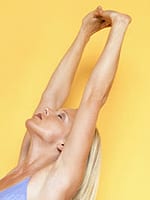Additional Body Procedures

Brachioplasty, commonly known as an arm lift, attempts to procure a more natural and youthful look by removing the fat and excess skin hanging down from the underarms. This is most commonly requested by aging women, but some men opt to have this procedure as well. An arm lift is often performed on post-bariatric surgery patients who have lost huge amounts of weight in a short amount of time. The procedure helps to relieve patients’ self consciousness in wearing short sleeves or otherwise showing their arms.
The Arm Lift (Brachioplasty) Procedure
During the arm lift procedure, the incision is made beneath the arm and can extend from the elbow to the armpit, varying upon how much skin must be removed. The skin is then cut away from the rest of the arm and pulled taut around the extremity.
This procedure is very likely to leave a scar that could be noticeable. Most doctors can adjust where they make their incision so that the cut runs either underneath the arm or on the inside surface. These are less visible in normal poses and can improve over time as the scar fades. However, most patients need to be firmly aware that they are essentially trading “skin for scars” with this procedure
Recovery From an Arm Lift
The initial recovery time for this procedure is short, as the patient may return to light work within a week or less. However, exercise must remain off limits for two weeks. The results will be immediately obvious, but will show apparent improvement over the next two weeks as swelling subsides. The scars will heal and mature over the next six months, possibly fading from sight entirely.
Body lift (Belt Lipectomy)

Also called belt lipectomy, torsoplasty and panniculectomy, the circumferential body lift is performed to remove excess skin from the torso and upper legs.
Candidates for Body Lifts
Candidates for body lifts typically suffer from loose (inelastic) skin on many or most areas of the body as a result of age, childbearing or significant weight loss due to diet, exercise or bariatric surgery. Because of this, the procedure is often combined with others such as breast lifts, arm lifts and liposuction to retain a proper body proportion. Body lifts tighten and tone the abdomen, back, buttocks, hips and thighs.
The Body Lift Procedure
During the procedure, skin is lifted from underlying tissue, muscles are tightened and stitched, fat is removed where necessary, and the skin is sutured closed. The navel is often removed and replaced in its new position. Surgical tubes may be needed for a few days to drain any fluid, and patients may need to wear compression garments for a few weeks to facilitate faster healing.
After the Body Lift Procedure
After surgery, patients are encouraged to walk as soon as they are able to, although strenuous activities must be limited for about a month. Results are visible immediately.
Thigh Lift

A thigh lift is performed to tighten the skin around the inner thigh to form a more aesthetically pleasing frame. The outer thigh is generally not targeted in a thigh lift as liposuction and a butt lift tend to produce better results in that area of the leg.
The Thigh Lift Procedure
This procedure requires a surgical incision of varying size based on how much skin must be removed. The location of the incision is usually on the medial side of the thigh and can be adjusted based on clothing preference or overall reduction of visibility.
After the Thigh Lift Procedure
After surgery, the patient is dressed in a compression garment to limit swelling. Discomfort is generally minimal in smaller lifts, but when large amounts of skin are removed, an overnight stay in the hospital may be required. In either case, pain medication and anti-inflammatory methods will be utilized.
Light labor is normally possible after less than two weeks, while most physical activity is permissible at four to six weeks. All symptoms should be gone and scars maximally faded within six months.
